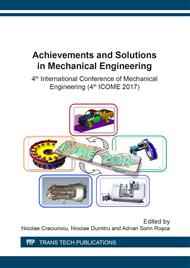[1]
J. Banhart, J. Baumeister, M. Weber, Powder Metallurgical Technology for the Production of Metallic Foams, Proceedings of the European Conference on Advanced PM Materials, (1995), 201-208.
Google Scholar
[2]
M. Haesche, D. Lehmhus, J. Weise, M. Wichmann, I.C. MagnaboscoMocellin, Carbonates as Foaming Agent in Chip-based Aluminium Foam Precursor, J. Mater. Sci. Technol, 26-9 (2010), 845-850.
DOI: 10.1016/s1005-0302(10)60135-1
Google Scholar
[3]
A. Byakova, I. Kartuzov, S. Gnyloskurenko, T. Nakamura, The Role of Foaming Agent and Processing Route in Mechanical Performance of Fabricated Aluminium Foams, ADV MATER SCI ENG, Article ID 607429, Vol 2014 (2014).
DOI: 10.1016/j.mspro.2014.07.608
Google Scholar
[4]
A. Ibrahim, F. Zhang, E. Otterstein, E. Burkel, Processing of porous Ti and Ti5Mn foams by spark plasma sintering, Materials and Design 32 (2011) 146–153.
DOI: 10.1016/j.matdes.2010.06.019
Google Scholar
[5]
T. Koizumi, K. Kido, K. Kita, K. Mikado, S. Gnyloskurenko,T. Nakamura, Foaming Agents for Powder Metallurgy Production of Aluminium Foam, Materials Transactions, 52-4 (2011, 728- 733.
DOI: 10.2320/matertrans.m2010401
Google Scholar
[6]
C. E. Wen, Y. Yamada, P. D. Hodgson, fabrication of novel metal alloy foams for biomedical applications, Materials Forum, 29 (2005), 274-277.
Google Scholar
[7]
G. Ryan, A. Pandit, D. PanagiotisApatsidis, Fabrication methods of porous metals for use in orthopaedic applications, Review, Biomaterials 27 (2006) 2651–2670.
DOI: 10.1016/j.biomaterials.2005.12.002
Google Scholar
[8]
A. Kennedy, Porous Metals and Metal Foams Made from Powders, Materials Science » Metals and Nonmetals » Powder Metallurgy, book edited by KatsuyoshiKondoh, ISBN 978-953-510071-3, Published: March 9, (2012).
DOI: 10.5772/33060
Google Scholar
[9]
B. Friedrich, K. Jessen, G. Rombach, Aluminum foam – Production, Properties and Recycling Possibilities. Erzmetall 2003; 56(11): 656-660.
Google Scholar
[10]
Y. Y. Zhao, D. X. Sun, A Novel Sintering-Dissolution Process for Manufacturing Al Foams. ScriptaMaterialia 2001; 44: 105–110.
DOI: 10.1016/s1359-6462(00)00548-0
Google Scholar
[11]
M. F. Ashby, A. Evans, N. A. Fleck, L. J. Gibson, J. W. Hutchinson, H. N. G. Wadley, Metal foams-a design guide. Butterworth-Heinemann, London, (2000).
DOI: 10.1016/b978-075067219-1/50001-5
Google Scholar
[12]
B. Ashok Kumar, C. Naga Kumar, V. Chengal Reddy, Production of low cost aluminium foams, International Journal of Current Engineering and Technology, INPRESCO, ISSN 2277-4106, 2014, 40-44.
Google Scholar
[13]
Z. Linxi, Y. Quanzhan, Z. Guirong, Z. Fangxin, S. Gang, Y. Bo, Additive manufacturing technologies of porous metal implants, China Foundry – Special report, 11-4 (2014), 322-331.
Google Scholar
[14]
A. V. Byakova, S. V. Gnyloskurenko, A. I. Sirko, Y. V. Milman, T. Nakamura, The Role of Foaming Agent in Structure and Mechanical Performance of Al Based Foams, Materials Transactions, 47-9 (2006), 2131-2136.
DOI: 10.2320/matertrans.47.2131
Google Scholar
[15]
A. V. Byakova, S. V. Gnyloskurenko, T. Nakamura, The Role of Foaming Agent and Processing Route in the Mechanical Performance of Fabricated Aluminium Foams, Metals 2 (2012), 95-112; doi: 10. 3390/met2020095.
DOI: 10.3390/met2020095
Google Scholar
[16]
V. Kevorkijan, Low cost aluminium foams made by CaCO3 particulates, Association of Metallurgical Engineers of Serbia, M JoM, 16-3 (2010), 205-219.
Google Scholar
[17]
S. deFátima Ferreira Mariotto, V. Guido, L. Y. Cho, C. Pacheco Soares, K. R. Cardoso, Porous Stainless Steel for Biomedical Applications, Materials Research, 14-2 (2011), 146-154.
DOI: 10.1590/s1516-14392011005000021
Google Scholar
[18]
C.E. Wen, Y. Yamada, P.D. Hodgson, Fabrication of novel metal alloy foams for biomedical applications, MATERlALS FORUM VOLUME 29 (2005), 274-277.
Google Scholar
[19]
Timmermans, Physico-chemical constants of pure organic compounds, Elsevier, (1950).
Google Scholar
[20]
D. Roberts, L. Cooper, U.S. Patent 2. 268. 621 (1942), H. Pfleumer, U.S. Patent 2. 297. 022 (1942).
Google Scholar
[21]
P. Achidrowitz, R. ungar, British Patent 538. 624 (1941).
Google Scholar
[22]
R.H. Koppel, German Patent 563. 165 (1931).
Google Scholar


